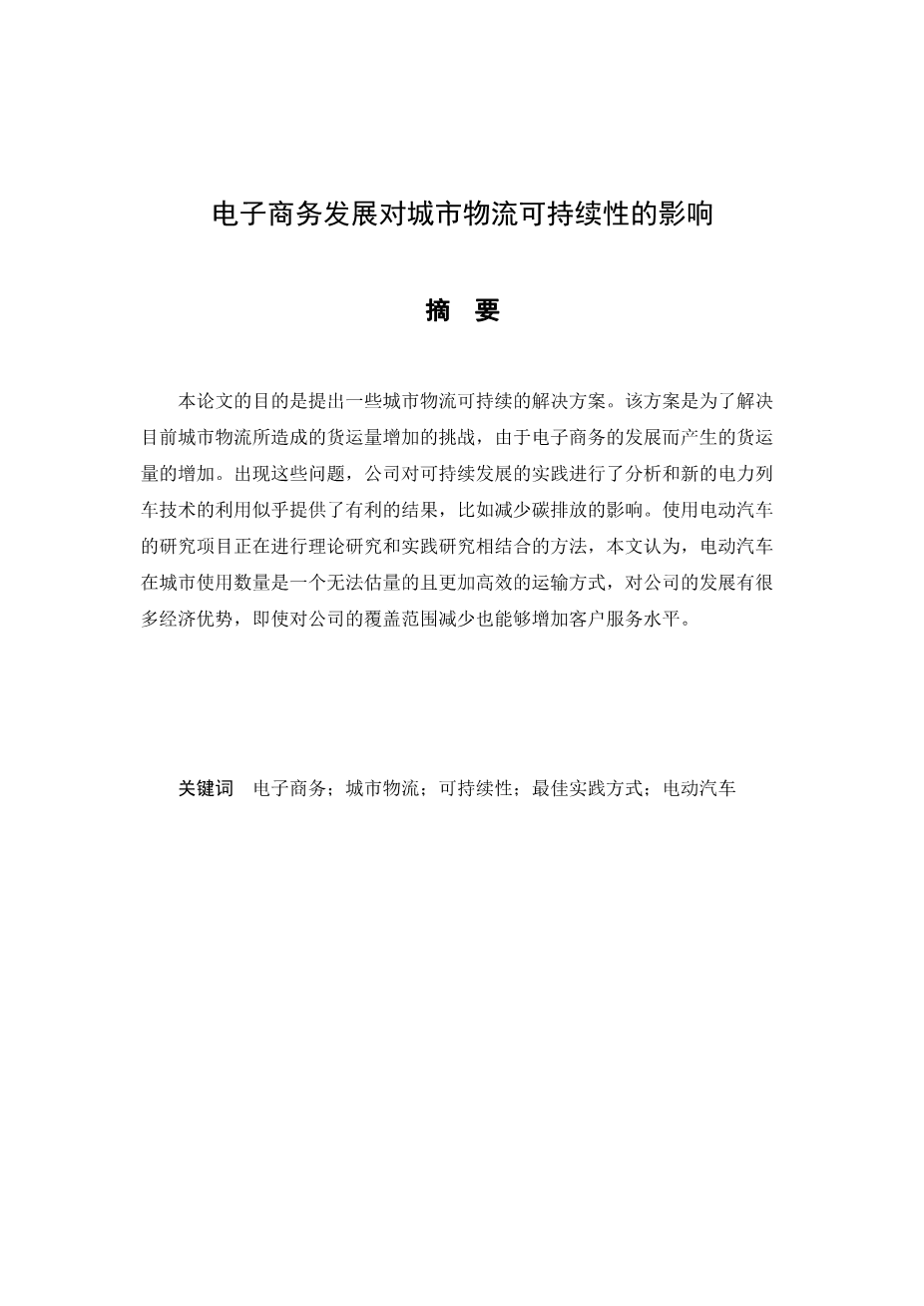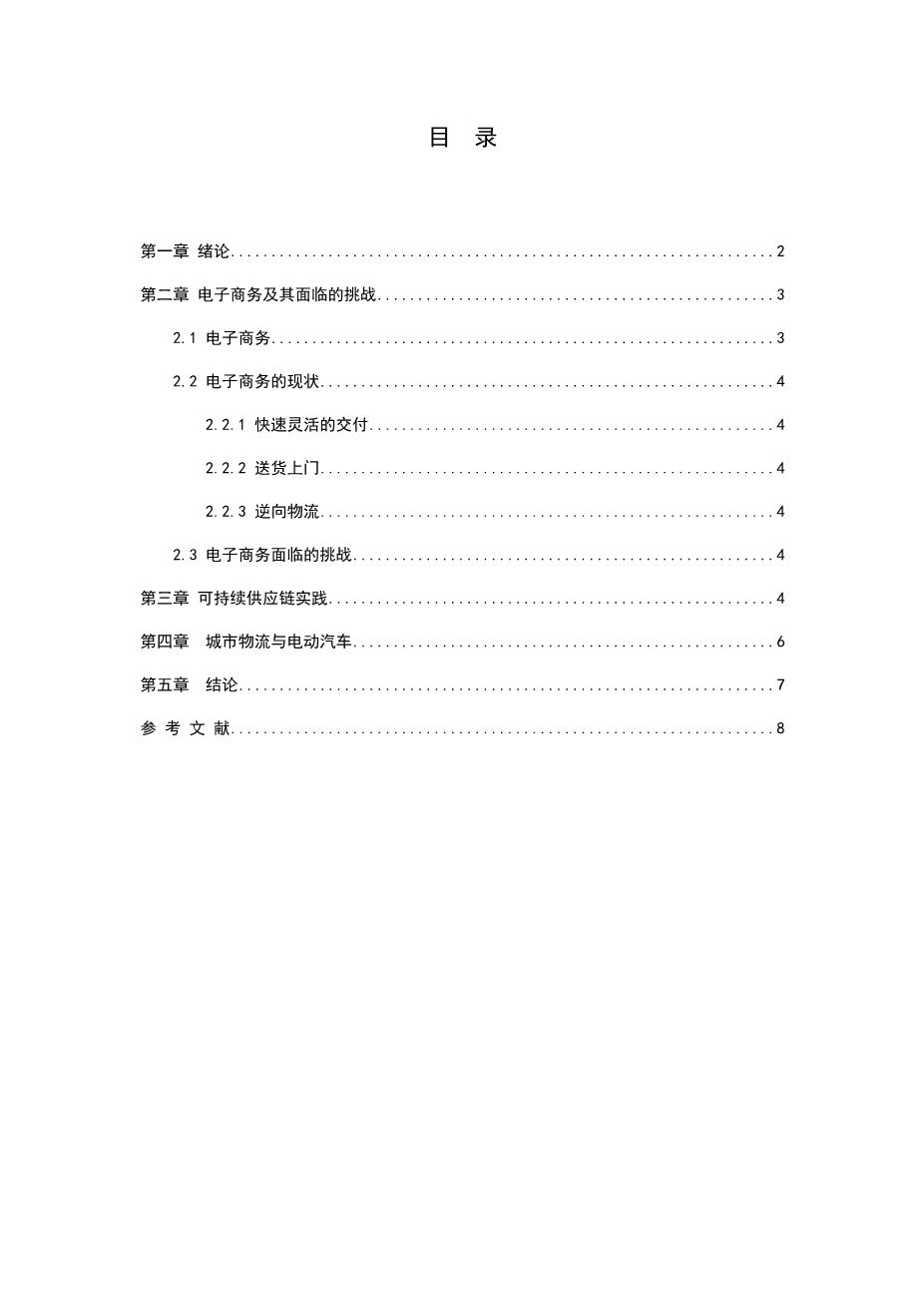Open Journal of Social Sciences, 2016, 4, 1‐6
Published Online March 2016 in Sci Res. http://www.scirp.org/journal/jss
http://dx.doi.org/10.4236/jss.2016.43001
The Impact of E-Commerc Development on Urban Logistics Sustainability
Dustin Schouml;der, Feng Ding, Juliana Kucht Campos
Technische Universitauml;t Berlin, Straszlig;e des 17. Juni 135, 10623 Berlin, Germany
Received 16 February 2016; accepted 26 February 2016; published 1 March 2016
Abstract
The purpose of the present paper is to present some sustainable solutions for urban logistics. The approach is to identify the present challenges for urban logistics caused by the increase of freight volumes due to the development of e‐commerce. To meet them, companiesrsquo; sustainable practices were analyzed and the utilization of new electric power train technologies seem to offer interesting results for reducing carbon emission impacts. Using methods of literature review and experiences from ongoing electric mobile research projects, this paper argues that electric vehicles in urban distribution are a yet underestimated element towards more efficient transport processes—hence economic advantages for companies, towards the reduction of a companyrsquo;s footprint and even towards an increased service level for the customers.
Keywords
E‐Commerce, Urban Logistics, Sustainability, Best Practices, Electric Vehicles
1. Introduction
Sustainable urban logistics has received much attention in recent years, due to continuously increasing freight volumes in e-commerce. Online shopping is a modern retail channel which, in alignment with the global trend of urbanization, leads to increased commercial traffic, congestions and hence pollution in areas with dense population. Many companies already introduce sustainable initiatives in order to reduce their ecological footprint both in terms of sustainable production and sustainable distribution. Simultaneously new electric power trains in vehicles provide an opportunity towards emission free transport. However, this new technology is mostly not considered within companiesrsquo; sustainable initiatives, yet.
The present paper presents key challenges of e-commerce and an approach towards sustainable urban logistics by using electric vehicles and by further integration of all participants within the transport chain, which corresponds with companiesrsquo; sustainable initiatives.
2. E‐Commerce and Its Challenges
E-commerce currently appears to be one of the fastest growing marketing channels for different kinds of products and services for consumers. Buyers and sellers that engage in E-commerce retail trade are no longer restricted by store hours, geographic marketing areas, or catalog mailing lists. In Figure 1? it is expected that the global B2C e-commerce trades are going to reach the value of 2.356 trillion dollars and the percentage of the global GDP account for 1.61% in the year 2018, almost nearly twice with year 2013. According to the e Markete r^ forecast, Asia-Pacific, which just about 16% of the total population but account for as many as 46% of all digital buyers in the world, is now expected to become the leading region for e-commerce sales in 2015, representing a 33.4% share next year, compared to 31.7% in North America and 24.6% Western Europe (Figure 2). ^ '
Furthermore, due to the development of communication technology, mobile e-commerce and social media will rapidly gain in importance. Mobile traffic to e-commerce sites has increased from 3% to nearly 37% in the last four years. Social media is evolving in much the same way, in 2015, 5% of all online retail revenue is forecasted to be attributable to social media, representing a sizeable $14 billion [1]. Moreover, cross-border online shopping is worth $105 billion in 2013 with 94 million consumers regularly buying from overseas websites. By 2018, this will increase nearly 200% to $307 billion with 130 million cross-border online shoppers [2].The reasons for the stated developments in online shopping are better prices, larger selection, convenience, and time savings [3]. However, because the online products is likely to be packaged individually and hard to return them, a further increase of internet shopping will lead to more deliveries and an increasing freight volume in residential area. It may have some negative effects like congestion issues, environmental concern and traffic safety etc. To solve this problem, sustainable urban logistics solutions are required in the city centers [4].Distinct from offline business models, e-commerce is characterized by higher interactivity, 24/7 availability and hence an increased importance of logistics processes. The logistical systems of many companies are not sufficient to manage the new challenges.
Figure 1. Global B2C E-commerce sales and percentage o f GDP from 2013 to 2018 (in billion U.S. dollars) [1].
Figure 2. B2C E-commerce sales share worldwide, by region, from 2013 to 2018 [1].
1) Fast and flexible deliveries: A positive delivery (or return) experience is essential in order to create customers loyalty to e-retailers. Concerns with delivery remain a barrier for consumers shopping online for physical goods, specifically when looking to shop cross-border. In addition, flexibility in delivery location and flexibility in delivery time slots are becoming increasingly relevant to consumers. Furthermore, tends to favor faster transportation modes can increase fuel consumption exponentially and may lead to inefficient utilized transport capacities.
2) Home delivery: The most i
剩余内容已隐藏,支付完成后下载完整资料


英语译文共 11 页,剩余内容已隐藏,支付完成后下载完整资料
资料编号:[613349],资料为PDF文档或Word文档,PDF文档可免费转换为Word
课题毕业论文、文献综述、任务书、外文翻译、程序设计、图纸设计等资料可联系客服协助查找。


